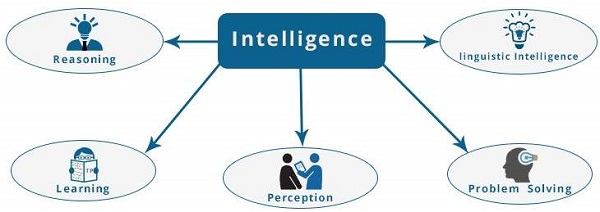While studying artificially intelligence, you need to know what intelligence is. This chapter covers Idea of intelligence, types, and components of intelligence.
What is Intelligence?
The ability of a system to calculate, reason, perceive relationships and analogies, learn from experience, store and retrieve information from memory, solve problems, comprehend complex ideas, use natural language fluently, classify, generalize, and adapt new situations.
Types of Intelligence
As described by Howard Gardner, an American developmental psychologist, the Intelligence comes in multifold −
| Intelligence | Description | Example |
|---|---|---|
| Linguistic intelligence | The ability to speak, recognize, and use mechanisms of phonology (speech sounds), syntax (grammar), and semantics (meaning). | Narrators, Orators |
| Musical intelligence | The ability to create, communicate with, and understand meanings made of sound, understanding of pitch, rhythm. | Musicians, Singers, Composers |
| Logical-mathematical intelligence | The ability of use and understand relationships in the absence of action or objects. Understanding complex and abstract ideas. | Mathematicians, Scientists |
| Spatial intelligence | The ability to perceive visual or spatial information, change it, and re-create visual images without reference to the objects, construct 3D images, and to move and rotate them. | Map readers, Astronauts, Physicists |
| Bodily-Kinesthetic intelligence | The ability to use complete or part of the body to solve problems or fashion products, control over fine and coarse motor skills, and manipulate the objects. | Players, Dancers |
| Intra-personal intelligence | The ability to distinguish among one’s own feelings, intentions, and motivations. | Gautam Buddhha |
| Interpersonal intelligence | The ability to recognize and make distinctions among other people’s feelings, beliefs, and intentions. | Mass Communicators, Interviewers |
You can say a machine or a system is artificially intelligent when it is equipped with at least one and at most all intelligences in it.
What is Intelligence Composed of?
The intelligence is intangible. It is composed of −
- Reasoning
- Learning
- Problem Solving
- Perception
- Linguistic Intelligence

Let us go through all the components briefly −
- Reasoning − It is the set of processes that enables us to provide basis for judgement, making decisions, and prediction. There are broadly two types −
| Inductive Reasoning | Deductive Reasoning |
|---|---|
| It conducts specific observations to makes broad general statements. | It starts with a general statement and examines the possibilities to reach a specific, logical conclusion. |
| Even if all of the premises are true in a statement, inductive reasoning allows for the conclusion to be false. | If something is true of a class of things in general, it is also true for all members of that class. |
| Example − "Nita is a teacher. Nita is studious. Therefore, All teachers are studious." | Example − "All women of age above 60 years are grandmothers. Shalini is 65 years. Therefore, Shalini is a grandmother." |
- Learning − It is the activity of gaining knowledge or skill by studying, practising, being taught, or experiencing something. Learning enhances the awareness of the subjects of the study.The ability of learning is possessed by humans, some animals, and AI-enabled systems. Learning is categorized as −
- Auditory Learning − It is learning by listening and hearing. For example, students listening to recorded audio lectures.
- Episodic Learning − To learn by remembering sequences of events that one has witnessed or experienced. This is linear and orderly.
- Motor Learning − It is learning by precise movement of muscles. For example, picking objects, Writing, etc.
- Observational Learning − To learn by watching and imitating others. For example, child tries to learn by mimicking her parent.
- Perceptual Learning − It is learning to recognize stimuli that one has seen before. For example, identifying and classifying objects and situations.
- Relational Learning − It involves learning to differentiate among various stimuli on the basis of relational properties, rather than absolute properties. For Example, Adding ‘little less’ salt at the time of cooking potatoes that came up salty last time, when cooked with adding say a tablespoon of salt.
- Spatial Learning − It is learning through visual stimuli such as images, colors, maps, etc. For Example, A person can create roadmap in mind before actually following the road.
- Stimulus-Response Learning − It is learning to perform a particular behavior when a certain stimulus is present. For example, a dog raises its ear on hearing doorbell.
- Problem Solving − It is the process in which one perceives and tries to arrive at a desired solution from a present situation by taking some path, which is blocked by known or unknown hurdles.Problem solving also includes decision making, which is the process of selecting the best suitable alternative out of multiple alternatives to reach the desired goal are available.
- Perception − It is the process of acquiring, interpreting, selecting, and organizing sensory information.Perception presumes sensing. In humans, perception is aided by sensory organs. In the domain of AI, perception mechanism puts the data acquired by the sensors together in a meaningful manner.
- Linguistic Intelligence − It is one’s ability to use, comprehend, speak, and write the verbal and written language. It is important in interpersonal communication.
Difference between Human and Machine Intelligence
- Humans perceive by patterns whereas the machines perceive by set of rules and data.
- Humans store and recall information by patterns, machines do it by searching algorithms. For example, the number 40404040 is easy to remember, store, and recall as its pattern is simple.
- Humans can figure out the complete object even if some part of it is missing or distorted; whereas the machines cannot do it correctly.
No comments:
Post a Comment